Overview
38 years is a long time, particularly in the world of cameras where every year the sensor resolution seems to double and the technology gets exponentially better. I often hear people talk about how sharp modern lenses are, but I question if lenses of the past were really that bad.
In this comparison, we will be comparing the Minolta 35mm f2.8 lens, now sold for only about $50 on ebay, vs. the $800 Zeiss 35mm f2.8, released 38 years later in 2015.
The 35mm & 50mm lens are probably the two most common focal lengths, as both offer a normal perspective without the complications involved with making super wide-angle or telephoto lenses.
How far has lens technology come in the past few decades?
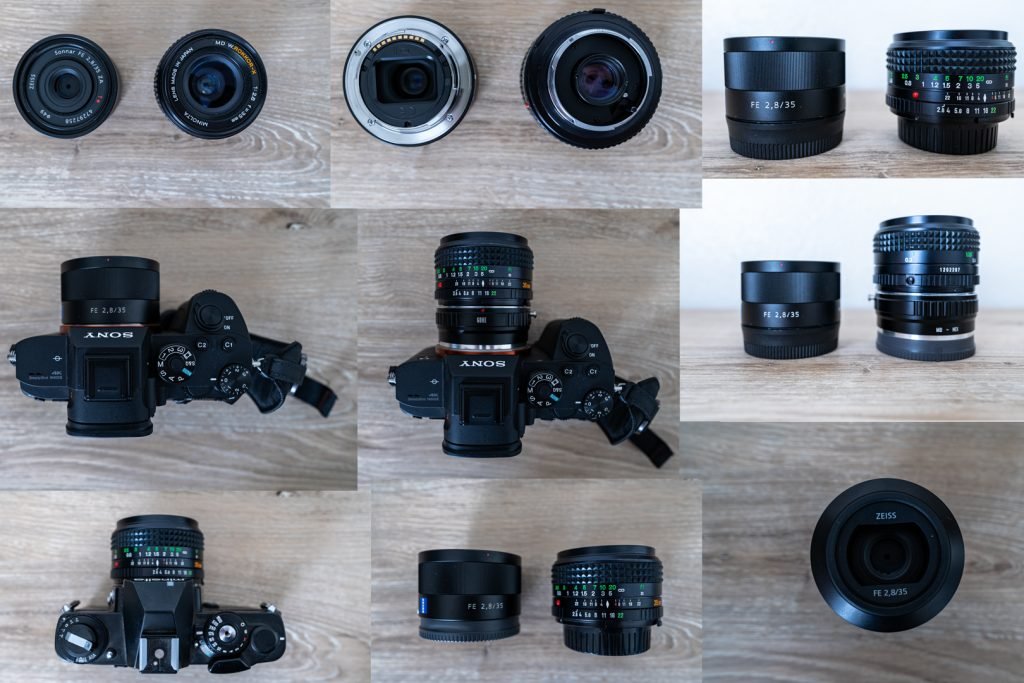
Build Quality
The Minolta 35mm has a very solid heft to it, weighing in at about 208g, it feels quite sturdy. There is often an association between weight and quality, and this lens is made entirely of metal. The only plastic part is the aperture ring, which is unfortunate. The earlier “MC” version of these lenses had all-metal construction, this is the later “MD” version which was the beginning of more plastic being used in these lenses. Nonetheless, the aperture ring clicks nicely in place and feels fairly solid. This particular copy is in great condition, with hardly any scratches or dust, and seems minimally used. I also very much like the orange “Rokkor-X” lettering engraved on the front. It balances very well on a Minolta camera, but is slightly front-heavy on a Sony with the adapter.
The Zeiss 35mm was one of the first lenses released for Sony’s new E-Mount system. The E-Mount system was actually based off of Minolta’s Alpha line of cameras that Sony acquired in 2006, so it is possible this lens could have incorporated some of the design from its ancient predecessor.
The Zeiss 35mm is extremely lightweight. It weighs only about 120g in total, making it almost half the weight of the Minolta. It basically feels like you are just holding the camera with no lens attached at all and feels very well balanced. It has no aperture ring or anything on the barrel except that signature blue Zeiss badge. The lens appears, at first glance, to be all metal, however as is common with most modern lenses, it is really just a sleek metal shell with all plastic internals, which helps keep it light. The one complaint I have about the Zeiss metal used on these lenses is it is SUPER easy to scratch and nick, where the Minolta metal is honestly pretty solid and doesn’t show wear very easily.
The Zeiss also has a weird lens hood that is extremely compact. The filter thread on the lens hood is 40.5mm, an unusual size which is why I rarely used it.
The Zeiss and Minolta are about the same size, with the Minolta only being a couple mm taller and thicker. However, the Zeiss also has an autofocus motor and does not extend when zoomed, where the Minolta does extend slightly as you zoom in and out. The Zeiss is super easy to slip into a bag as an extra lens, and I have taken it to many places even though I didn’t use it all the time, it is nice to have as a “backup” lens and is the smallest lens you can buy for the Sony -E-Mount system.
When used with an adapter, the Minolta is quite a bit less compact than the Zeiss, as you would expect.
The Zeiss has 7 elements in 5 groups with 3 aspherical elements to reduce aberrations and imperfections in the image, while the Minolta uses a rather barebones 5 elements in 5 groups structure. The Zeiss also has their special *T coating which reduces flare. The Zeiss has no weather sealing ring, but claims moisture resistance as it fits so tightly that it supposedly keeps moisture out. It is designed to be a lightweight travel lens more than a professional tool, but still overall seems to be good quality. I won’t be comparing focus since the Minolta doesn’t have autofocus, but the AF on the Zeiss is fast and surprisingly snappy and quiet.
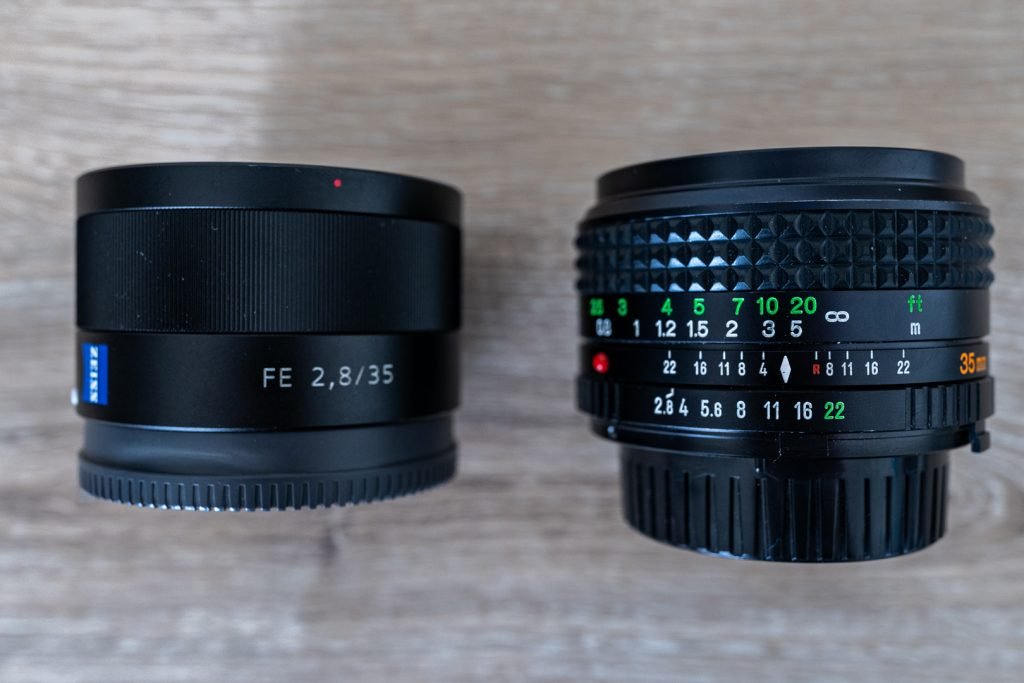
Performance
This is where things get rather interesting. Wide open at f/2.8, the Minolta is somewhat sharp in the center, then gets rather mushy and soft towards the edges. Pretty much what I expected.
However, when I shot the Zeiss at f2.8, I was surprised to see it is only slightly sharper in the center, and also gets quite soft in the corners as well. I was expecting the Zeiss to be super sharp across the frame, but it is actually only a bit better than the Minolta, even wide open. I repeated this test several time on a tripod, with all manuel settings and focus, and the results were still the same.
I honestly thought the Zeiss would completely blow the Minolta away, but its actually pretty close.
Alright, before I say which one is which, can you guess?


The biggest difference isn’t really the sharpness as much, but more the vignetting. As you can see, the vignetting on Minolta is much more pronounced and also, you can see that despite both lenses being “35mm”, the definition of 35mm is apparently a bit loose as the Zeiss has a slightly tighter perspective than the Minolta so the images aren’t the EXACT same perspective due to this slight difference.
The vignetting could also possibly be due to the adapter though, which causes a slight amount of light loss. Without the adapter on a native Minolta, I think the vignetting would be far less pronounced.
Stopping down to F/4, the vignetting improves significantly, and the gap between the two lenses narrows even more, with the Zeiss MAYBE ever so slightly sharper.
By F5.6, the two lenses look pretty damn similar to me.
By F8, which is where most landscape photographers shoot, the difference is basically negligible, and so on to F11, then by F16-F22, both lenses get softer again.
Here is a quick chart comparison between the two.
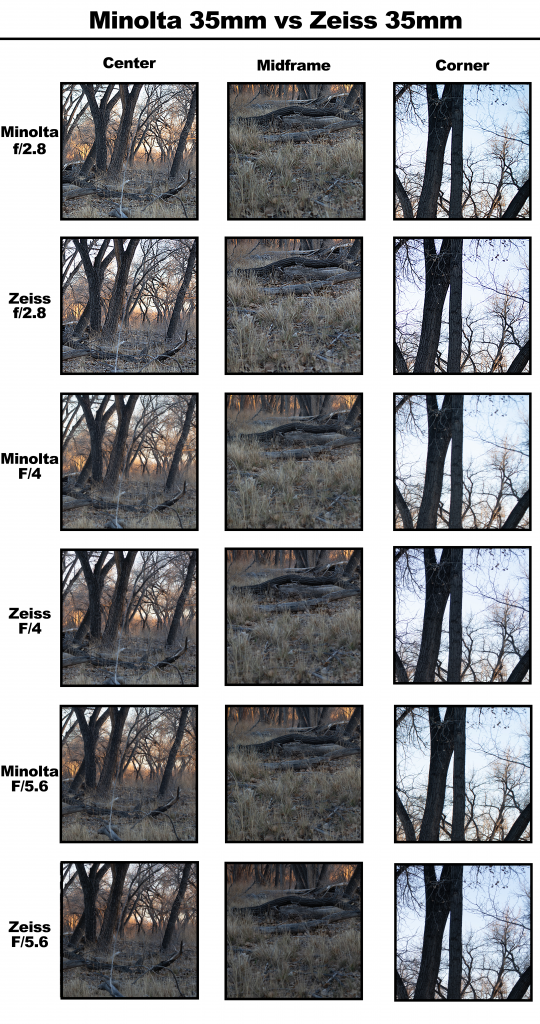
I was originally going to keep going all the way to F/22, but its honestly not even worth it. We are basically just comparing apples to apples at that point. These two lenses look almost exactly the same.
It seems the Zeiss is just barely a bit sharper across the frame at all apertures. Barely.
Chromatic Aberrations
Wide-open, both lenses have a pretty significant amount of aberrations in the corners and high-contrast areas. I can’t really say which is worse, but the Zeiss has 3 aspherical elements and a special coating which are supposed to reduce this kind of thing. Doesn’t seem like all that fancy engineering does much here though because they look pretty similar. The aberrations do go away a bit when stopped down but not completely. It raises the question of how much of a difference having tons of extra aspherical elements and coatings really makes in real-world use.
Minolta (Left) Zeiss (Right). The Zeiss actually almost seems a little worse, it looks a bit more purplish while the Minolta is more bluish (The white balance and temp are exactly the same on both images)


Sunstars
Vintage lenses have never really been known for having good sunstars, but here it’s extremely apparent. With 7 aperture blades, the Zeiss produces 14-point sunstars which, compared to many modern lenses, aren’t really that visually appealing to me. However, the Minolta’s 5-blade sunstars do not look good, even when completely stopped down. They are ugly and undefined, although to be fair this is what most vintage sunstars look like. Clearly, aperture blade technology has advanced significantly over the past few decades.


Flare
This is where the Zeiss *T coating actually does show a big difference. A common weakness of almost all vintage lenses is flare performance and the Minolta is no exception. When shooting directly into the sun, the Zeiss shows very little flare, even without the lens hood. It was very difficult to produce flares, although I’m sure not impossible.
The Minolta shows rather ugly flare shooting right into the sun, and even when shooting to the side of the sun, still shows a significant loss of contrast as seen below. Lens coatings have also clearly advanced significantly over the past few decades.
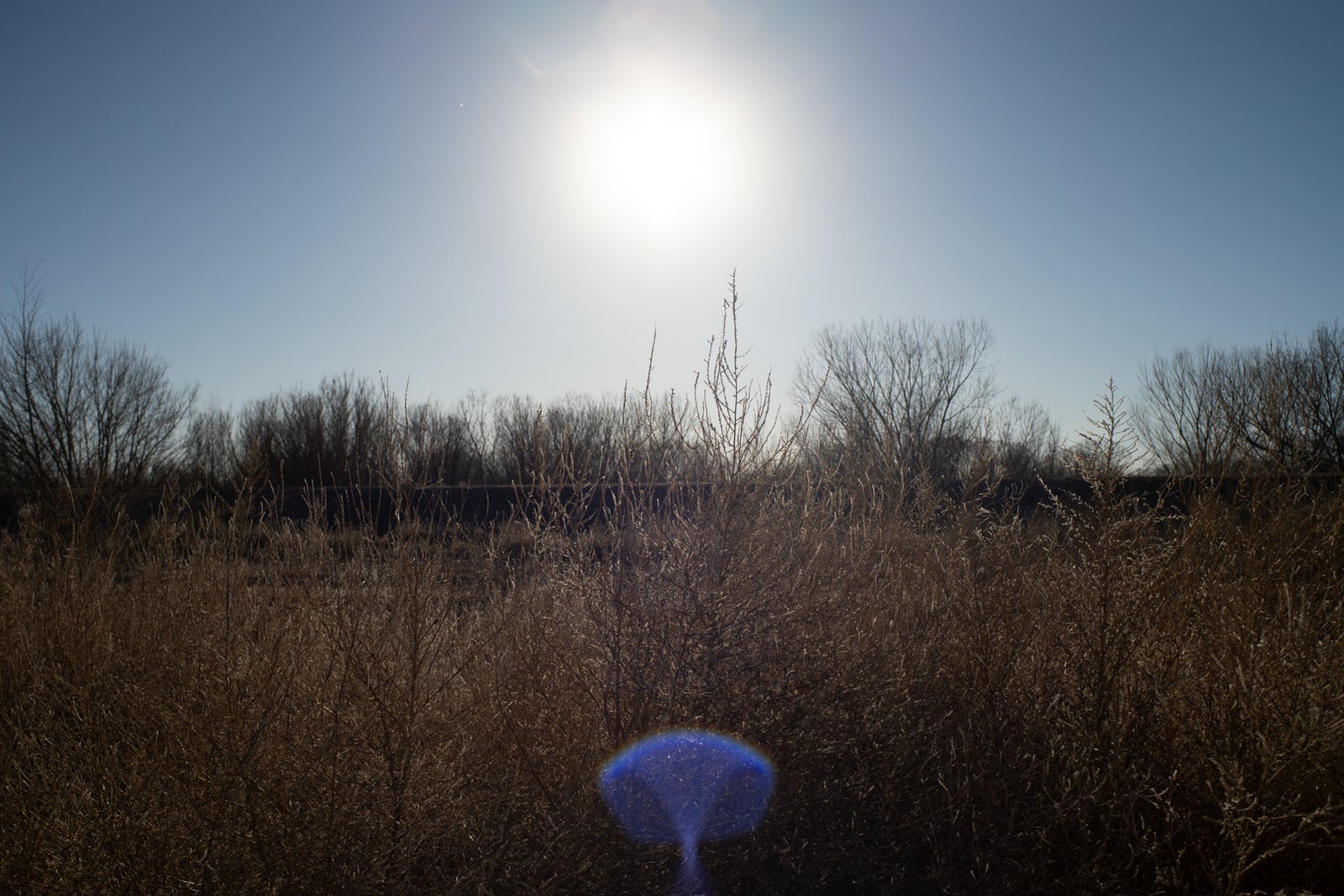
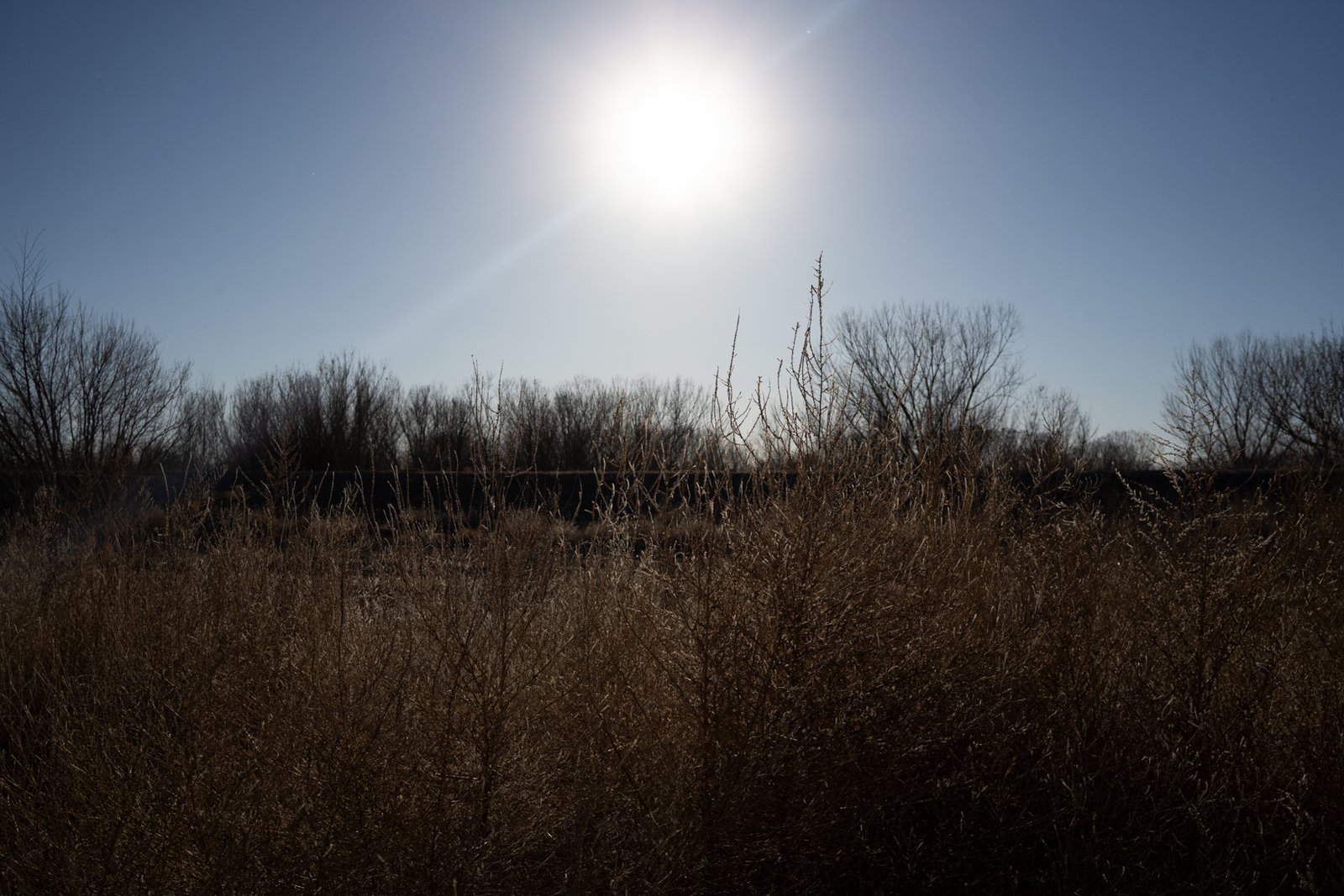

Bokeh
EVERYBODY LOVES BOKEH. Just kidding. 35mm and below lenses aren’t really known to have much bokeh, so this isn’t really a strong suit of these types of somewhat wide-angle lenses.
However, I did want to see if the Zeiss has more round bokeh than the “cats-eye” shape that is quite common on most vintage lenses.


Nope! The bokeh is actually… also very similar. The Zeiss actually has some rather unattractive “onion ring” texture inside the bokeh balls, while the Minolta has slightly larger and a bit smoother bokeh. This actually took me by surprise as I expected the Zeiss to have super nice bokeh and the Minolta to have terrible bokeh but its actually almost the opposite.
When stopped down, both show a hexagonal shape, but again the Minolta has slightly larger and smoother bokeh balls where the Zeiss has a bit of onion rings inside the bokeh.
Onion rings are caused by the aspherical elements inside the lens, and interestingly the lack of all these extra elements actually benefits the Minolta quite a bit here.
While these 3 aspherical elements found in the Zeiss do help with contrast, astigmatism, and other aberrations, there are tradeoffs from using them as you can see here.

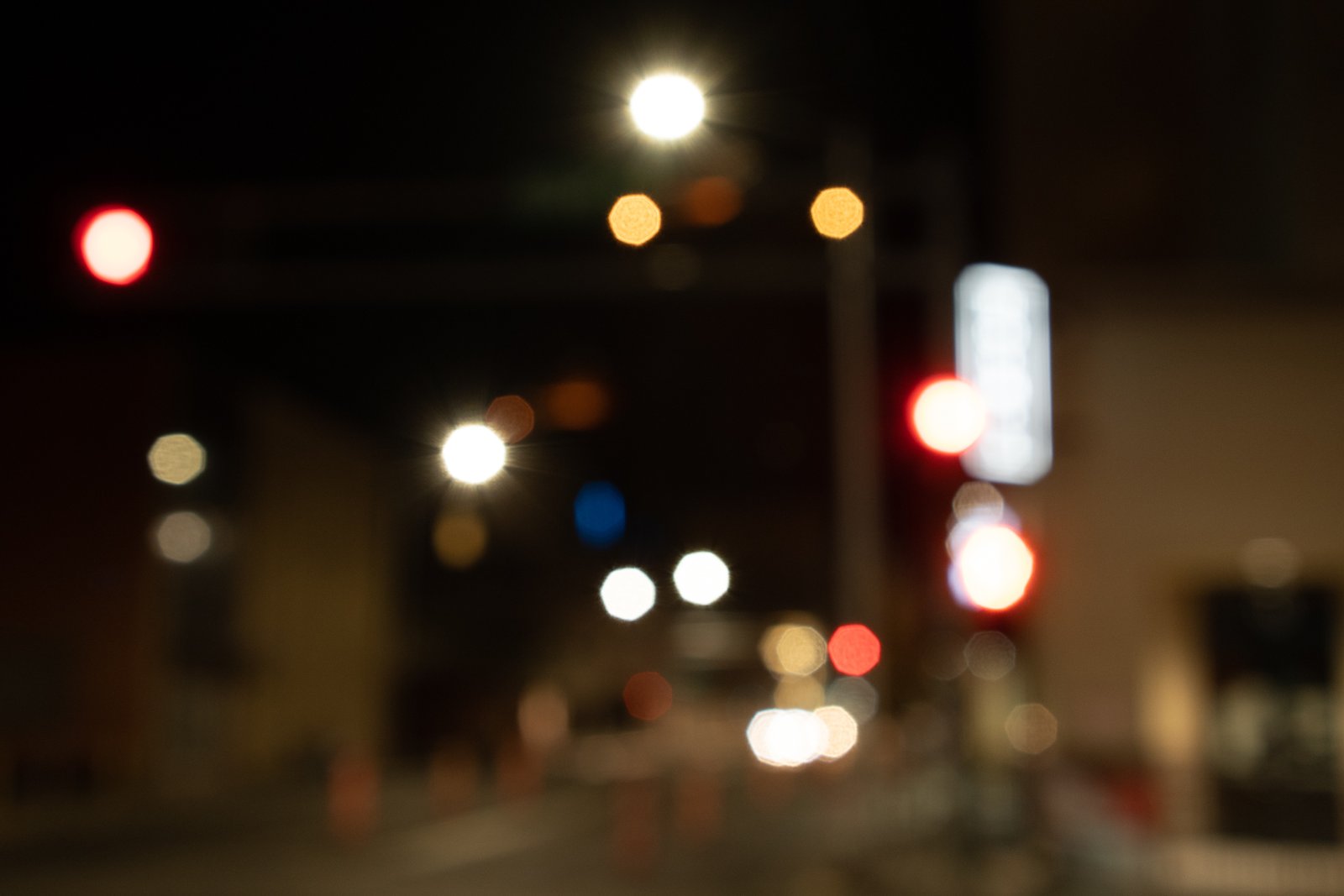
Conclusion
I learned quite a lot from this comparison and it has taught me a few things about lenses which I did not know previously.
The first thing I learned which surprised me most is that modern lenses actually haven’t advanced as much as cameras have in the past 40 years or so.
A lens really is just a bunch of glass arranged in a certain shape that you can look through. Sure, there have been many advancements in coatings, arrangement of elements, autofocus motors, and, in particular, zoom lenses, but I think prime lenses are so simple in design that even decades later they have not changed massively.
While camera sensors seem to be getting better and better, glass has really seemed to hit point of only marginal improvement as it seems even many years ago people had already figured out how to make great lenses.
At $800, the Zeiss really doesn’t perform nearly as well as I expected it to, while on the used market it can be found for closer to about $400 or so, the Minolta is incredibly cheap at only about 50-$100 and has performance that is quite remarkable.
Recently Sony just announced the 35mm f1.4 GM lens which is much sharper than the considerably more expensive Zeiss 35mm f1.4 released several years ago. I’m sure this lens would blow the Minolta out of the water, but its also literally 2700% more expensive. Anyone who can afford a 35mm G-Master likely isn’t using vintage primes.
Anyways, the overpriced Zeiss is clearly designed to emphasize probability over image quality, and its optical performance is still quite good considering it also has an autofocus motor in such a compact design.
I’m not sure if Minolta’s engineers were overachieving or Zeiss engineers were slacking, maybe its a combination of the two, but this comparison shows that even vintage lenses can be sharp.
The Zeiss is the smallest lens you can get for Sony E-Mount, has moisture resistance, better flare control and contrast, and autofocus.
For video, I think the Zeiss 35mm is still a much better option. Moza even has a cheap, lightweight gimbal that is made specifically for the A7-series and 35mm f2.8 combination as any other lens would be much too heavy.
The Minolta has much more durable construction, a WAY cheaper price, better bokeh due to lack of aspherical elements, and optical performance that is basically just as good as the Zeiss, which is what surprised me most.
If you are a photographer looking to try out the 35mm perspective on a budget, its hard to beat the Minolta. It punches far above its weight and has much better performance than I would expect it to.
Additional Information
Rokinon has a super cheap ($179) 35mm f2.8 lens that is comparable in size, weight, and performance to the Zeiss that is also a nice option. The build quality still isn’t as good but its worth considering, I haven’t used it myself but its clearly meant to offer similar performance for less money.
Test Charts for Minolta 35mm f2.8
Test Charts for Zeiss 35mm f2.8
Sony has a newer 35mm f1.8. It lacks the compact size of the Zeiss but has a much faster aperture.
Minolta has a 35mm f1.8 lens as well, but it is quite rare and expensive which makes it really not worth the price unless your a collector.
Minolta also has a very rare and expensive 35mm f2/8 Shift lens, a really unique lens that has tilt-shift capabilities. If I had lots of money, I would buy one just as a collectors item because it looks cool.

